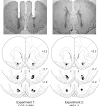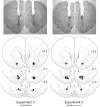The effects of nucleus accumbens μ-opioid and adenosine 2A receptor stimulation and blockade on instrumental learning
- PMID: 25101542
- PMCID: PMC4181594
- DOI: 10.1016/j.bbr.2014.07.047
The effects of nucleus accumbens μ-opioid and adenosine 2A receptor stimulation and blockade on instrumental learning
Abstract
Prior research has shown that glutamate and dopamine receptors in the nucleus accumbens (NAcc) core are critical for the learning of an instrumental response for food reinforcement. It has also been demonstrated that μ-opioid and adenosine A2A receptors within the NAcc impact feeding and motivational processes. In these experiments, we examined the potential roles of NAcc μ-opioid and A2A receptors on instrumental learning and performance. Sprague-Dawley rats were food restricted and trained to lever press following daily intra-accumbens injections of the A2A receptor agonist CGS 21680 (at 0.0, 6.0, or 24.0ng/side), the A2A antagonist pro-drug MSX-3 (at 0.0, 1.0, or 3.0μg/side), the μ-opioid agonist DAMGO (at 0.0, 0.025, or 0.025μg/side), or the opioid receptor antagonist naltrexone (at 0.0, 2.0 or 20.0μg/side). After five days, rats continued training without drug injections until lever pressing rates stabilized, and were then tested with a final drug test to assess potential performance effects. Stimulation, but not inhibition, of NAcc adenosine A2A receptors depressed lever pressing during learning and performance tests, but did not impact lever pressing on non-drug days. Both μ-opioid receptor stimulation and blockade inhibited learning of the lever-press response, though only naltrexone treatment caused impairments in lever-pressing after the task had been learned. The effect of A2A receptor stimulation on learning and performance were consistent with known effects of adenosine on effort-related processes, whereas the pattern of lever presses, magazine approaches, and pellet consumption following opioid receptor manipulations suggested that their effects may have been driven by drug-induced shifts in the incentive value of the sugar reinforcer.
Keywords: Adenosine; Learning; Motivation; Nucleus accumbens; mu-Opioid receptor.
Copyright © 2014 Elsevier B.V. All rights reserved.
Figures




Similar articles
-
The role of nucleus accumbens adenosine-opioid interaction in mediating palatable food intake.Brain Res. 2010 Jan 8;1306:85-92. doi: 10.1016/j.brainres.2009.09.115. Epub 2009 Oct 12. Brain Res. 2010. PMID: 19822132 Free PMC article.
-
Nucleus accumbens dopamine and mu-opioid receptors modulate the reinstatement of food-seeking behavior by food-associated cues.Behav Brain Res. 2011 Jun 1;219(2):265-72. doi: 10.1016/j.bbr.2011.01.024. Epub 2011 Jan 22. Behav Brain Res. 2011. PMID: 21262268
-
Increases in food intake or food-seeking behavior induced by GABAergic, opioid, or dopaminergic stimulation of the nucleus accumbens: is it hunger?Psychopharmacology (Berl). 2004 Mar;172(3):241-7. doi: 10.1007/s00213-003-1654-0. Epub 2003 Nov 4. Psychopharmacology (Berl). 2004. PMID: 14598017
-
Dopamine/adenosine interactions involved in effort-related aspects of food motivation.Appetite. 2009 Dec;53(3):422-5. doi: 10.1016/j.appet.2009.07.018. Epub 2009 Jul 25. Appetite. 2009. PMID: 19635514 Free PMC article. Review.
-
Endogenous mu-opioid modulation of social connection in humans: a systematic review and meta-analysis.Transl Psychiatry. 2024 Sep 17;14(1):379. doi: 10.1038/s41398-024-03088-3. Transl Psychiatry. 2024. PMID: 39289345 Free PMC article.
Cited by
-
Proopiomelanocortin projections to the nucleus accumbens modulate acquisition and maintenance of operant palatable pellet administration in mice.Physiol Behav. 2023 Jun 1;265:114176. doi: 10.1016/j.physbeh.2023.114176. Epub 2023 Mar 23. Physiol Behav. 2023. PMID: 36965574 Free PMC article.
-
Homeostatic-related peptides injected into the rat nucleus accumbens alter palatable eating and impact the binge-like intake of a sweetened fat diet during simultaneous μ-opioid receptor stimulation.Front Neurosci. 2025 Jul 14;19:1614819. doi: 10.3389/fnins.2025.1614819. eCollection 2025. Front Neurosci. 2025. PMID: 40726519 Free PMC article.
-
Anticipatory Behavior for a Mealworm Reward in Laying Hens Is Reduced by Opioid Receptor Antagonism but Not Standard Feed Intake.Front Behav Neurosci. 2020 Jan 14;13:290. doi: 10.3389/fnbeh.2019.00290. eCollection 2019. Front Behav Neurosci. 2020. PMID: 31992974 Free PMC article.
-
The role of dorsomedial striatum adenosine 2A receptors in the loss of goal-directed behaviour.Psychopharmacology (Berl). 2023 Mar;240(3):547-559. doi: 10.1007/s00213-022-06220-7. Epub 2022 Sep 21. Psychopharmacology (Berl). 2023. PMID: 36129491
-
Striatopallidal adenosine A2A receptor modulation of goal-directed behavior: Homeostatic control with cognitive flexibility.Neuropharmacology. 2023 Mar 15;226:109421. doi: 10.1016/j.neuropharm.2023.109421. Epub 2023 Jan 10. Neuropharmacology. 2023. PMID: 36634866 Free PMC article. Review.
References
-
- Hernandez PJ, Sadeghian K, Kelley AE. Early consolidation of instrumental learning requires protein synthesis in the nucleus accumbens. Nat Neurosci. 2002;5:1327–31. - PubMed
-
- Parkinson JA, Dalley JW, Cardinal RN, Bamford A, Fehnert B, Lachenal G, et al. Nucleus accumbens dopamine depletion impairs both acquisition and performance of appetitive Pavlovian approach behaviour: implications for mesoaccumbens dopamine function. Behav Brain Res. 2002;137:149–63. - PubMed
Publication types
MeSH terms
Substances
Grants and funding
LinkOut - more resources
Full Text Sources
Other Literature Sources
Research Materials

